56.8 Editing the Desktop Management Preboot Services Menu
When a PXE-enabled workstation is booted, it broadcasts for DHCP information and receives a response from both the DHCP and Proxy DHCP servers. The workstation then downloads the Preboot Services client and checks for imaging work with the Transaction server. If there is imaging work to do, the workstation displays a default Desktop Management Preboot Services (PXE) Menu with the following options:
|
HISTORICAL NOTE |
|---|
|
The PXE (Preboot Execution Environment) environment provided by PreWorX is used for Windows and NetWare imaging servers. Novell’s internally-developed PXE solution for Linux imaging servers in ZENworks 7 with SP1 supports the SLES-based ZENworks Imaging distribution. The PXE process based on PreWorX files differs from Novell’s solution. For example, PreWorX uses a combination of Caldera* DOS, the linld Linux loader program, and .cmd configuration files for passing parameters to the Linux kernel. Novell’s PXE solution is based on the pxelinux boot loader and .cfg configuration files. Therefore, depending on where the Preboot Services Menu file resides, there are two methods for editing the menu. One menu is provided by PreWorX for Windows for imaging servers, the other by Novell for Linux for imaging servers. Contact PreWorX for their toolkit if more capability is needed in editing the menu in Windows. |
Review the applicable sections for instructions on editing the Preboot Services Menu:
56.8.1 Editing the Preboot Services Menu on Linux
There might be circumstances when you want to modify the options on the Preboot Services Menu. You can customize these options by editing a text file contained on the Linux imaging server. For example, you can:
-
Add, delete, and modify menu options
-
Change the color scheme
-
Change the menu title and screen name
The following procedure should be done on each ZENworks Imaging server where you want to customize the menu.
To edit the Preboot Services Menu:
-
In a text editor, open the following file on a ZENworks Imaging server where novell-proxydhcp is running:
/srv/tftp/pxemenu.txt
IMPORTANT:If you want to save the default options for this menu, we recommend that you make a backup copy of pxemenu.txt, such as pxemenu_orig.txt.
The following is the content of the default Preboot Services Menu’s pxemenu.txt file:
#This file describes a PXEMenu ScreenName = Novell Preboot Services Menu ScreenInfo = Version 1.0 August, 2005 MenuTitle = ZENworks Preboot Options #The screen colors determine the color of the main part of the menu screen ScreenColor = bright_white ScreenBackgroundColor = blue #The info colors determine the color of the screen information at the top #of the menu screen InfoColor = yellow InfoBackgroundColor = blue #The hint colors determine the color of the hint line at the bottom of the screen HintColor = lt_cyan HintBackgroundColor = blue #The menu colors determine the color of the menu box and menu title MenuColor = yellow MenuBackgroundColor = blue #The option colors determine the color of the menu option OptionColor = BRIGHT_WHITE OptionBackgroundColor = BLUE #The chosen colors determine the color of the high-lighted option ChosenColor = BRIGHT_WHITE ChosenBackgroundColor = RED #Maximum of 9 menu items MenuOptionCount = 7 option1 = Start ZENworks Imaging option2 = Start ZENworks Imaging Maintenance option3 = Disable ZENworks Partition option4 = Enable ZENworks Partition option5 = Exit CFG1 = z_auto.cfg CFG2 = z_maint.cfg CFG3 = z_zpdis.cfg CFG4 = z_zpen.cfg CFG5 = 0 Hint1 = ZENworks Imaging in Automated Mode Hint2 = ZENworks Imaging Linux Session in Interactive Mode Hint3 = Disable Existing ZENworks Partition Hint4 = Re-enable a Disabled ZENworks Partition Hint5 = Boot to Local Hard Drive
-
To change the appearance of the menu, edit the first seven sections (title and colors).
To change colors, the mnemonics you enter must be selected from the following:
BLACK
RED
GRAY
LT_GREEN
BLUE
MAGENTA
YELLOW
LT_CYAN
GREEN
BROWN
BRIGHT_WHITE
LT_RED
CYAN
WHITE
LT_BLUE
LT_MAGENTA
-
To change the menu options, edit the last four sections, beginning with MenuOptionCount.
The menu options, their code, and their hint descriptions are correlated by the number (see “#” where used below).
MenuOptionCount: This number must match the total number of options defined in the next three sections. The limit is 9 menu options.
option#: Displayed in the menu as the option’s text.
CFG#: The configuration file that is used upon selecting the menu option.
Hint#: Displayed at the bottom of the screen to explain the selected menu option’s function. It changes as you select a menu option.
IMPORTANT:If you add or subtract a menu option, make sure that you do the same thing to each of the last three sections. The numbering should be consecutive (such as 1 through 5). Be sure to keep the corresponding items matched in each of the last three sections.
-
When finished, save the pxemenu.txt file.
56.8.2 Understanding the Windows-based Preboot Services Menu Editor
If you want to create a custom Preboot Services (PXE) menu, you can use the Desktop Management Preboot Services Menu Editor to set and run your own actions and DOS utilities on the client workstation. Novell provides this utility as a service; no custom DOS or Linux utilities have been developed by Novell.
NOTE:Contact PreWorX for their toolkit if more capability is needed in editing the menu in Windows.
The Menu Editor is a Windows-based, option-driven utility that lets you do the following on the Preboot Services (PXE) menu:
-
Add menu items or submenus to the Preboot Services (PXE) menu
-
Add executable commands to be performed on the client workstation
-
Delete a submenu or an action from an existing menu
The Menu Editor generates menu files and stores them on the Desktop Management Preboot Services server. These files can be selected from the Menu Editor interface and downloaded to a Preboot Services client workstation.
Installing the Preboot Services Menu Editor
If you chose the Preboot Services component during the Desktop Management Preboot Services installation program, the Menu Editor is automatically installed on Windows servers you designate as Preboot Services servers. For more information, see Desktop Management Server Installation Procedure
in the Novell ZENworks 7 Desktop Management Installation Guide. The Menu Editor is not installed to a NetWare server during the Preboot Services installation; the files must be accessed from a Windows workstation.
Accessing the Preboot Services Menu Editor
If you installed to a Windows server, you can access the Menu Editor from the Windows desktop (after the PXE-enabled Windows workstation is imaged) by clicking > > > .
If you need to access the Menu Editor from a NetWare server, do the following:
-
Unzip the \zenworks\sfiles\InstallerData\Installer.zip file from the Novell ZENworks 7 Desktop Management Support Pack 1 CD to a temporary directory.
-
From the $SHADE_SOURCE_PATH$\ZEN Preboot Services_zg_ia_sf.jar file, copy the Menu Editor directory to your NetWare server.
-
On a Windows machine, map to the Menu Editor directory copied on the NetWare server in Step 2. Run the Menu Editor.
Understanding the Preboot Services Menu Editor Interface
The Menu Editor interface is not available unless you are creating or editing an existing menu. Add and delete functions are available from the Options menu or from icons on the toolbar. Menu Editor functions can also be initiated with keyboard commands from a Windows workstation. For example, pressing the Insert key while in the Menu Editor adds a menu item, and pressing the Delete key deletes a menu item.
You can enter descriptive text about the menu in the field. You can also add help by entering appropriate text in the field.
56.8.3 Editing the Preboot Services Menu on Windows
Although you could use the default Preboot Services (PXE) Menu for Desktop Management Preboot Services, you might want to take advantage of the flexibility of the Preboot Services Menu Editor to create a new menu or to modify the default menu.
This section contains the following information:
Modifying the Default Menu
There might be circumstances that require you to limit the options on the Desktop Management Preboot Services (PXE) menu. For example, you might want to restrict the user from using the Linux bash command line options. In such a case, you must create a new default menu and copy it to proper location on the Preboot Services server.
The following steps assume that you want to overwrite the existing default menu. If you want to save the options of this menu, we recommend that you rename defmenu.mnu (for example, defmenu_old.mnu), edit it with the Menu Editor to meet your needs, then save it again as defmenu.mnu.
To modify the default menu:
-
In the Windows desktop, click > > > to display the following dialog box:
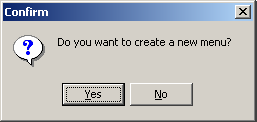
-
Click to display the menu files that reside in the directory from which meditor.exe is running.
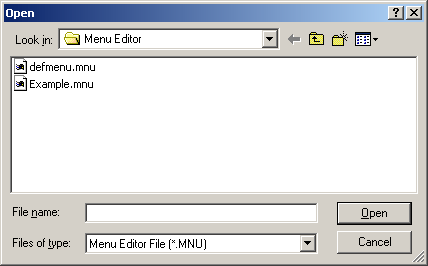
-
Select (or browse to) the defmenu.mnu file that you want to change, then click .
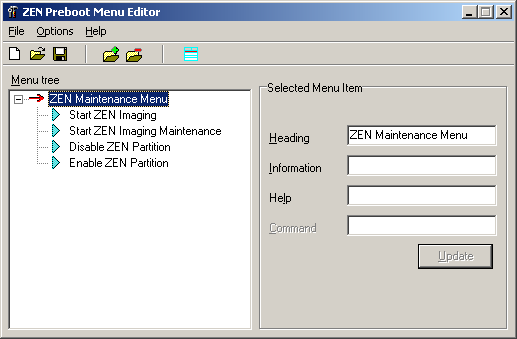
-
Select the menu item that you want to delete, click , then click to display a message similar to the following:
Do you want to delete Start ZENworks Imaging Maintenance and its subitems? -
Click to return to the Menu Editor, then click > to open the Save As dialog box.
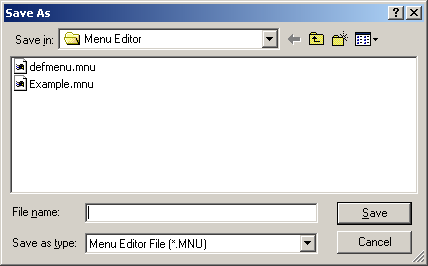
-
Select defmenu.mnu to enter this filename in the field, then click . The following prompt is displayed:
Do you want to overwrite the old file?
-
Click to overwrite the file and to return to the Menu Editor window.
You have now modified the defmenu.mnu menu template.
-
In the Menu Editor window, click > to reopen the Save As dialog box.
-
In the drop-down list, select (*.dat).
-
Select defmenu.dat to enter this filename in the field, then click . The following prompt is displayed:
Do you want to overwrite the old file?
-
Click to overwrite the file and to return to the Menu Editor window.
You have now modified the data file that is displayed as the menu on a PXE workstation.
-
Copy the new defmenu.dat file to the /tftp directory on the Preboot Services server.
Creating a New Preboot Services (PXE) Menu
Use the following steps to create a new Preboot Services (PXE) menu using the Desktop Management Preboot Services Menu Editor:
-
In the Windows desktop, click > > > to display the following dialog box:

-
Click to display the Create Menu dialog box.
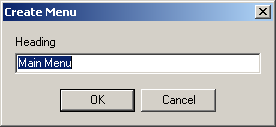
-
Specify the name of menu you want to create, then click to display the ZENworks Preboot Menu Editor window.
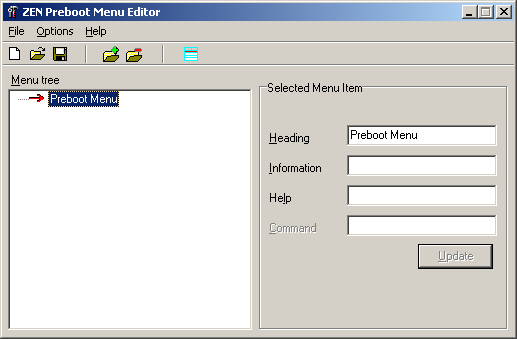
Creating a Submenu
If you want to create your own functions for the Preboot Services (PXE) menu, you need to create a submenu of these functions. Use the following steps to create a submenu.
-
Select from the Options menu to display the Add Menu Item window.
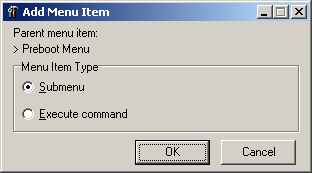
-
Select , then click to display the Add Menu dialog box.
-
In the field of the dialog box, specify the text you want to use as the option in the submenu, then click .
The Menu Editor displays the submenu option as a subordinate item to the main menu you have already created.
-
Type a description and the help text in the and fields.
-
Click to save the text of the submenu option and any accompanying text you have created.
Although the submenu item is now created and appears on the Preboot Services (PXE) menu, it does not launch any utility; it is merely a text heading that serves as a navigation tool to options that actually perform functions.
Creating Functions Within the Menu
As stated earlier in this document, Desktop Management Preboot Services ships with a Preboot Services (PXE) menu that allows only limited, predesigned actions from the client workstation. Novell does not ship other DOS or Linux utilities. However, if you want to add functionality of your own, you can do so with the Preboot Services Menu Editor.
To add executable commands to the Menu Editor:
-
In the Preboot Services Menu Editor window, select a menu item, click , then click to display the Add Menu Item window.
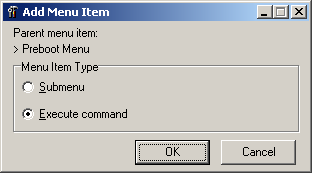
-
Select , then click .
-
In the Execute Command dialog box, specify the menu text that describes the functionality of your program, then click .
-
Specify the command parameters of the utility you want to run, then click .
-
Specify descriptive text about the item you have created, then click .
-
Specify any help text that you want to be accessible by an F1 command for this menu item, then click .
-
When you have finished creating the menu, click > to save the structure.
By default, the file is saved in .mnu format, which is used as a template by the Preboot Services Menu Editor interface. To be used by the Preboot Services (PXE) menu, this file must be exported to a binary (.dat) format. For more information, see Saving the Menu as a .Dat File.
Saving the Menu as a .Dat File
To create a .dat file for the Preboot Services (PXE) menu using a .mnu file:
-
Open the Preboot Services Menu Editor, then click to display the existing .mnu files saved to your default directory (the same directory where the menu editor, meditor.exe, resides).
-
Select the .mnu file of the menu you want to export for later use by the Preboot Services (PXE) menu, click , then click .
-
In the drop-down list, select (*.dat).
-
In the field, type DEFMENU, then click to return to the Menu Editor window.
You have now created a data file that can be displayed as the default menu on a PXE-enabled workstation.
-
Copy the defmenu.dat file to the /tftp directory on the Preboot Services Server.
The .dat file is saved in the local directory from which you are running the Preboot Services Menu Editor. You must copy the file to the \tftp directory at the Preboot Services server.